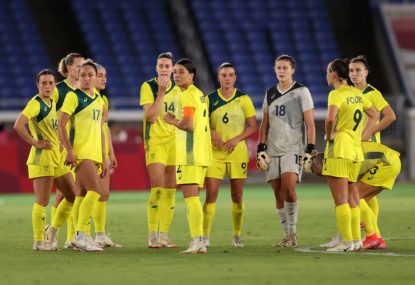Zac
new author
Roar Rookie
Opinion

The first signs of the USWNT’s game plan showed in just the fourth minute, with a Megan Rapinoe throw that made itself to an untracked Sam Mewis on the edge of the box.
The ball was sent wide to Christen Press, who dragged her marker inside, before laying the ball out wide for a cross. The USA did not have a long throw specialist of the ilk of Ellie Carpenter, but they knew how to create from them.
It continued just two minutes later. A throw to Crystal Dunn made a surge into the box, forcing a clearance turning possession over, which led to the ball once again hitting the wide area and a drive into the box, culminating in a shot by Press that Teagan Micah just got her fingertips to.
Now, the goal. A wonderfully curved ball direct from Rapinoe’s corner sails over Micah into the back of the net; how did it happen?
Undoubted is the level of skill and placement from Rapinoe, however, deliberate or not, it was part of a tactic seen often in these Olympics, especially of attempting to crowd the keeper within the six-yard box.
As the ball comes sailing in, Micah is left with little space to do what the majority of keepers favour to when a ball comes inside the six-yard box – go and claim it or punch it clear.
This blocking is done as much by the Matildas as it is the USWNT.
Eight Matildas are within the proximity to the four USWNT players. The crucial let down from this defensive shape is the lack of a player on the back post.

Teagan Micah (Photo by David Lidstrom/Getty Images)
If a team chooses to box in their own keeper, they must be able to cover the angles. This attacking tactic off the corner aims to hit into the space and hit on the rebound or create confusion and panic at the back.
By these measures, this corner was a success, trapping the keeper and finding the space. An exasperated Tameka Yallop is seen gesturing to the back post following the goal.
The second goal is less a tactical fault and more to the beat of a mis-clearance.
A quick sequence of passes at halfway drew in the Australian attackers before the ball was swiftly passed wide making excellent use of space, a quick pass in behind and a cross, the ball down unfortunately mistimed in the clearance and was well buried by Rapinoe.
Before looking at the third USWNT goal, it is important to look seven minutes prior to a moment bemoaned by many Australians.
The USWNT didn’t consistently press and choke the Australian defence, however, when they decided to, it was vicious.
Seen in the 38th minute, a ball is played from keeper into the centre to Emily van Egmond, a rushed pass back into the box is forced before a panicked pass wide is mis-controlled, seized upon by the opposition and culminates in a shot.
With three Australians inside the box, a rushed pass was played in to Van Egmond. She was identified as the deep lying playmaker and, similar to Sweden, has had a triangle formed around her that rapidly closes as the ball comes to her. This is the press trigger.
The ball is forced back, sending Rapinoe to press the furthest Australian in the box, Lloyd takes the central defender out as an option, while Christen Press is already running to the player likely to receive the ball, cutting out a return pass.

Megan Rapinoe (Photo by Franck Fife / AFP / Getty Images)
Two more USWNT players are seen as the ball progresses sprinting to cut passing lanes. An effective press that forces a turnover and a shot that is well saved by Micah.
It was also suggestive of what was to come as the remainder of the game had numerous moments of panic under such a well-drilled press, especially just 30 seconds later when Australia dribbled into their own box and a turnover just outside the six-yard box trying to force the play out from the back.
Australia lost the ball on three distinct occasions in an effort to play out from the back between the 36th minute and the third US goal. Eventually, this did get switched up with a long ball from the back resulting in a foul in the lead-up.
What is vital to note for how this goal occurred is the amount of energy that trying to break a press requires, and with minimal rotation in the build-up, this sudden change to the pace of the game was a clear tactical adjustment to try and jump upon a team winding down the end of a half.
By this point, teams are waiting to get back to the changing room and, having suffered a barrage of intense, highly-structured presses, it takes its toll. And it is because of this toll that as the half closed out, there was a poor decision to dribble back into the Australian half by Kyah Simon and mis-control the ball.
Still pressing, Lindsey Horan was able to win back the ball, cross into the gaps of a defence expecting control of the ball and allow a deftly executed finish by Carli Lloyd.
While the second half proved far stronger for the Matildas, a few early losses of possession rattled them, leading to the misjudged and tired head back from Kennedy being picked up by an energetic Lloyd.
In conclusion, there were a few factors at play in the Matildas’ loss. The most obvious was the effects of fatigue.
Sam Kerr coming off the back of a 26-game season in the WSL followed by playing every minute of the Olympics showed by the end, despite her superb individual showings, her link-up play was diminished as she became tired.
Similarly, there were images in the first half of many players jogging back if the ball was won back by the USWNT at halfway, something a team full of energy would bemoan doing.
The USWNT had superb quality and superb tactical plans for moments of a game, seizing upon the common lapses in team cohesion and energy that is expected from tournaments.
While this article does highlight the pitfalls of this game from the Matildas, it is by no means an indictment on their showing, especially within their fightback in the second half and their efforts to get to the Bronze Medal final.